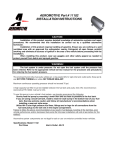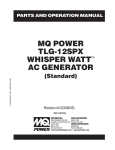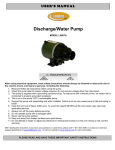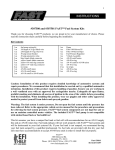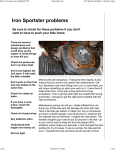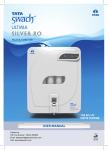Download 11101, 11108 & 11151 INSTALLATION INSTRUCTIONS
Transcript
11101, 11108 & 11151 INSTALLATION INSTRUCTIONS WARNING! The fuel system is under pressure. Do not open the fuel system until the pressure has been relieved. Refer to the appropriate vehicle service manual for the procedure and precautions for relieving the fuel system pressure. To use this pump in your vehicle’s fuel system, you must do the following: • • • • • • • • A by-pass style fuel pressure regulator must be used in the system. Utilize AN-10 size high pressure fuel lines, fittings and o-rings for all connections from the fuel tank pickup to the fuel pump. To ensure proper fuel pump performance and longevity, mount pump level with or lower than the bottom, and as close to the tank, as possible. Install a 12304 pre-filter and 12301 post filter. If you are using a stock fuel tank, install a reservoir sump in the bottom-rear of your fuel tank. Exercise extreme caution and follow all manufacturers’ recommendations when installing a reservoir sump. (Sump part # 18650) Tank/Fuel cell must have at least a ½” tank vent. If you choose not to install a reservoir sump, then you must install a high flow capacity fuel tank pickup (9/16” to 5/8” inner tube diameter). Installing pickup tube instead of a reservoir sump may shorten the fuel pump life and cause drivability problems. When using a pickup, you should maintain at least ½ tank of fuel to avoid possible engine lean-out and/or fuel pump damage. For long term driving applications where continuous run times exceed 30 minutes and fuel capacity is less then 10 gallons, Aeromotive recommends the installation of a Fuel Pump Speed Controller to maintain lower fuel temperatures in the tank. See Aeromotive Fuel Pump Speed Controller 16306. Failure to follow the above may result in fuel leakage, bursting of the fuel lines, poor vehicle performance and/or decreased fuel pump life! Improper installation will void all warranties for this product! CAUTION: Installation of this product requires detailed knowledge of automotive systems and repair procedures. We recommend that this installation be carried out by a qualified automotive technician. Installation of this product requires handling of gasoline. Ensure you are working in a well ventilated area with an approved fire extinguisher nearby. Extinguish all open flames, prohibit smoking and eliminate all sources of ignition in the area of the vehicle before proceeding with the installation. The enclosed Aeromotive fuel pump utilizes AN-10 ORB (O-ring Boss Ports) style inlet and outlet ports; these ports are NOT PIPE THREAD and utilize NO THREAD SEALANT. Compatible Fuels: Pump Gas Race Gas E85 Diesel Alcohol/Ethanol The following steps are typical of most installations: 1. Referring to the appropriate vehicle service manual for instructions, remove the OEM fuel pump. 2. Install an after-market sumped high flow capacity fuel tank or fuel cell, per the manufacturer’s instructions. 3. Find a suitable place on the vehicle chassis to mount the fuel pump. Make sure the location will accommodate the pump mounting bolts. Make sure to position the pump at or below the bottom of the tank. Make sure that the pump is clear of the exhaust, is clear of any moving suspension or drivetrain components and will keep the pump clear of road obstructions or debris. 4. Using the enclosed template, mark and drill four mounting holes to accept ¼” bolts. Mount the fuel pump using four ¼” bolts, nuts and lock washers. For quieter fuel pump operation use Aeromotive p/n 11601 fuel pump vibration dampening mounting kit. Note: Be sure to route all fuel lines clear of any moving suspension or drive train components, and any exhaust components! Protect fuel lines from abrasion and road obstructions or debris. 5. Using minimum of 9/16” ID or AN-10 fuel line, connect the fuel tank sump outlet to a 12304 fuel filter. Using the same size fuel line connect the fuel filter outlet to the fuel pump inlet, or if you are using an Aeromotive fuel filter you can attached the filter directly to the fuel pump utilizing an AN-10 fitting (15608) and 2 sealing o-rings (10AN o-ring pack 15623). Note: It is recommended that a fuel shut off valve be installed between the fuel tank outlet and the fuel pump. Use Aeromotive part # 12331 shutoff valve fuel filter and 15640 swivel fitting to make the connection. 6. Using AN-10 fuel line, connect the fuel pump outlet to the 12301 fuel filter. You can attached the filter directly to the fuel pump utilizing an AN-10 fitting (15608) and 2 sealing o-rings (10AN o-ring pack 15623). Make sure you use high pressure (150 psi minimum) fuel line for this connection! 7. Using AN-08 or AN-10 fuel line, connect the fuel filter outlet to the “Y” block (15620, 15675 or 15674). From the “Y” block use AN-08 lines to make the connection to the fuel rails. Make sure you use high pressure (150 psi minimum) fuel line for this connection! For optimum fuel system performance in EFI applications, Aeromotive recommends a balanced system with the fuel pressure regulator as the last component in the system as shown in the following diagram. Note: Be sure to route all electrical wires clear of any moving suspension or drivetrain components and any exhaust components! Protect wires from abrasion and road obstructions or debris. 8. Make sure you use stranded, insulated copper wire, in the sizes shown, with matching crimp-type connectors for all connections. 9. Locate the OEM fuel pump supply wires, located near the OEM fuel pump mounting location. Using that supply wire, connect the Aeromotive fuel pump as shown in the following diagram. 10. Attach a suitable, non-liquid filled fuel pressure gauge to the fuel system schrader valve, fuel rail or fuel pressure regulator. P/N 15632 0-15 PSI (1 ½”) “Dry” Fuel Pressure Gauge P/N 15633 0-100 PSI (1 ½”) “Dry” Fuel Pressure Gauge Ensure that any spilled fuel and any fuel soaked shop towels are cleaned up and removed from the vicinity of the vehicle. CAUTION: While performing the following steps, if any fuel leaks are detected, immediately turn the ignition to OFF, remove any spilled fuel and repair the leak(s) before proceeding! 11. Turn the ignition to ON without starting the engine, allow the pump to run for several seconds and check the fuel pressure. If there is no pressure, turn the ignition to OFF, wait one minute, then turn the ignition to ON and recheck the pressure. Repeat this ignition OFF and ON procedure until the gauge registers pressure or you detect a fuel leak. If no pressure is registered on the gauge after running the pump for several seconds and you have found no leaks, check all fuel and electrical connections to determine the cause. 12. Once the fuel pressure gauge registers pressure, start the engine. The fuel pressure gauge should register between 40 and 70 psi. If you have installed an adjustable fuel pressure regulator, adjust it to the desired setting. (For maximum fuel system performance, we recommend using an Aeromotive adjustable fuel pressure regulator; call us for info.) 13. Shut the engine off. Using suitable clips and other mounting hardware, secure the newly installed fuel lines and electrical wires by attaching them to the vehicle chassis. 14. Test-drive the vehicle to insure proper operation and re-check the fuel system for leaks. If any leaks are found, immediately discontinue use of the vehicle and repair the leak(s)! Aeromotive system components are not legal for sale or use on emission controlled motor vehicles. Thanks for purchasing another quality product designed, engineered and manufactured in Kansas City, USA! AEROMOTIVE, INC. 7805 Barton Street, Lenexa, KS 66214 913-647-7300 fax 913-647-7207 Fuel System Troubleshooting Pump does not run at all. Do you have voltage at the pump terminals? No Pump performs poorly or runs intermittently Check all electrical connections. Is the fuel pressure regulator you are using a by-pass style? Yes Is the “+”terminal connected to +12 V and the “-“ terminal connected to the battery ground cable? No Yes Connect power wires to proper terminals. Are you using a sumped fuel tank or a fuel cell? Yes Is the fuel line going to the engine compartment connected to the same side of the fuel pump as the power terminals? No Yes Do you have a 100-micron fuel filter installed on the inlet side of the fuel pump? Yes No No No Yes Plumb the fuel pump in the proper orientation. Is the fuel line between the fuel tank / fuel cell a minimum of 9/16” ID or AN-10? Debris may have entered the fuel pump and locked it up, Contact Aeromotive. No Yes Is the fuel pump mounted at or below the half tank fuel level? Contact Aeromotive No Yes Does the fuel filter on the inlet side of the pump have a 100-micron filtration rating and have a min. of 60 in2 area? No Yes Are the fuel filters in the system been clean or new? No Yes Contact Aeromotive No Are you driving the vehicle for periods of time greater then 30 minute with less the 10 gallons of fuel in the tank? Yes A by-pass style regulator is required for proper operation of this product. For EFI we recommend Aeromotive p/n 13101 or 13109. For carb applications we recommend Aeromotive p/n 13204. A sumped fuel tank or fuel cell is required for proper product performance, refer to Aeromotive tech bulletin #802 “Pickup tubes -vs- sump feed” for specific details. Clean, high flow inlet plumbing is required for proper pump operation, a min. of 9/16” ID or AN-10 fuel line is required on the pump inlet side. The fuel pump must be mounted such that it is gravity feed to insure a long and healthy life. The fuel filter on the inlet side of the fuel pump is required to be rated at 100-micron and have no less then 60 in2 filtering area, for detailed information refer to Aeromtive tech bulletin #101 titled “Inlet Filter”. Insure that all fuel filters are clean or new, proper filters are an inexpensive cure to a lot of fuel system problems. Refer to Aeromotive tech bulletin #102 titled “Post Pump Filtration”. As the fuel level falls in your tank it is being recirculated at an increasing rate, allowing less time for fuel cool down, in these cases it is recommended to use a Fuel Pump Speed Controller, we recommend Aeromotive p/n 16306. Aeromotive, Inc. Technical Bulletin #101 From: Aeromotive Technical Department Date: 10/10/2011 Re: Fuel Filtration: Selecting the correct filter to prevent lean-out and pump failure. STOP!! If you are selling or installing a fuel filter on the inlet of an Aeromotive fuel pump, be certain you do not use a filter that causes more problems than it solves. For pump inlet filtration, use only Aeromotive 100-micron P/N #12304, #12302 or an acceptable equivalent (see specifications below). Do not install the Aeromotive P/N #12301 or 12310 filter with 10micron fabric element on the inlet of any Aeromotive fuel pump, they are however perfect for use on the outlet of the pump, and this is the only location for which they are recommended. You may run any brand of filter you choose on your car, just be certain that it meets the following requirements: The filter element used on the inlet side of any Aeromotive fuel pump may be no finer than 100-micron (no number smaller than 100), with a surface area of 60 square inches or more. Any filter element not meeting these criteria may fail to flow the full volume of the pump, resulting in both vehicle drivability and pump reliability problems. Aeromotive fuel pumps are engineered to be efficient, and can create both high outlet pressure and high inlet vacuum. The boiling temperature of any liquid varies with pressure. For example, the engine’ cooling system is purposely designed to pressurize the coolant in order to raise the boiling point. So how does this apply to fuel delivery? When a fuel pump has to pull through a restriction to get fuel from the tank a vacuum develops which lowers the fuel’s boiling temperature, cavitating the fuel and turning it from liquid into vapor. Bottom line: Inlet restrictions create vacuum, which causes cavitation, which in turn causes vapor-lock and fuel pump damage. Of course, drivability problems and even engine damage can result! Lesson: Don’t combine high flow, efficient fuel pumps with poor flowing inlet filters. Don’t use fuel lines smaller than the pump ports. Don’t use fuel tank pick-ups or tank outlets smaller than the line. What about a fine filter? They are also necessary, but must be installed on the outlet side of your Aeromotive fuel pump, never on the inlet. Options include the Aeromotive 10-micron (replaceable element) fabric filter assemblies P/N #12301 and P/N #12310, and the new, high-flow 40-micron (cleanable element) stainless steel filter assembly P/N #12335. Given the alcohol content found in today’s pump gas, it is now necessary to frequently monitor and service any downstream fuel filters in use. Because they cannot be cleaned, keep a spare 10-micron element on hand for immediate service to eliminate engine fuel starvation and drivability problems when they become heavy clogged. All Aeromotive pumps except the Pro Series EFI pump may use the Aeromotive filter #12304 with –10 inlet and outlet fittings and 100-micron stainless steel element. The Pro Series EFI pump #11102 requires filter #12302 with larger stainless steel element and –12 inlet and outlet fittings. The #12302 is also recommended for the #11104 EFI Eliminator pump and our new #11105 belt drive pump (try 400gph or 2700lb/hr of fuel delivery at 100psi!!). Though Genuine Aeromotive Filters may be somewhat more expensive than the off-brand options, you simply must “compare apples to apples”. They say “a picture is worth a thousand words…” Above are various versions of “100-micron” fuel filters/elements. Note: the top element is the Aeromotive 100-micron element P/N #12604, as found the fuel filter assembly P/N #12304. Note the various filters all have “billet” housing, with AN connections, and can be disassembled for inspection and cleaning. Also, note that all are sold and recommended as appropriate pre-filters. Of course, it’s obvious by this comparison image that there’s more to a filter than the micron rating, a billet housing or even AN Connections. It should be equally clear that surface area, the amount of filter material available for fuel flow, is not at all related to micron rating, but a major key to a filters flow capacity. All these filters may be fine, well made assemblies, and perhaps they are suitable for use with various fuel pumps on various engines; However, excepting the very top element which is there for comparison, none of the above belong in any system featuring an Aeromotive fuel pump and certainly not any car, boat, truck, etc. that features an engine worthy of such a pump. AEROMOTIVE, INC. LIMITED WARRANTY This Aeromotive Product, with proof of purchase dated on or after January 1, 2003, is warranted to be free from defects in materials and workmanship for a period of one year from the original date of purchase. No warranty claim will be valid without authentic, dated proof of purchase. This warranty is to the original retail purchaser and none other and is available directly from Aeromotive and not through any point of distribution or purchase. If a defect is suspected, the retail purchaser must contact Aeromotive directly to discuss the problem, possible solutions and obtain a Return Goods Authorization (RGA), if deemed necessary by the company. Please call 913-647-7300 and dial option 3 for the technical service dept. All returns must be shipped freight pre-paid to the company and with valid RGA before they will be processed. Aeromotive will examine any product returned with the proper authorization to determine if the failure resulted from a defect or from abuse, improper installation, misapplication or alteration. Aeromotive will then, at it’s sole discretion, return, repair or replace the product. If any Aeromotive product is determined defective, buyer’s exclusive remedy is limited in value to the sale price of the good. In no event shall Aeromotive be liable for incidental or consequential damages. Aeromotive expressly retains the right to make changes and improvements in any product it manufactures and sells at any time. These changes and improvements may be made without notice at any time and without any obligation to change the catalogs or printed materials. Aeromotive expressly retains the right to discontinue at any time and without notice any Aeromotive product that it manufactures or sells. This warranty is limited and expressly limits any implied warranty to one year from the date of the original retail purchase on all Aeromotive products. No person, party or corporate entity other than Aeromotive shall have the right to: determine whether or not this Limited Warranty is applicable to any Aeromotive product, authorize any action whatsoever under the terms and conditions of this Limited Warranty, assume any obligation or liability of any nature whatsoever on behalf of Aeromotive under the terms and conditions of this Limited Warranty. This Limited Warranty covers only the product itself and not the cost of installation or removal. This Limited Warranty is in lieu of and expressly excludes any and all other warranties, expressed or implied. This Limited Warranty gives you specific legal rights, and you may also have other rights which vary from state to state. Aeromotive, Inc. 7805 Barton Street, Lenexa, KS 66214 Phone: (913) 647-7300 Fax: (913) 647-7207









